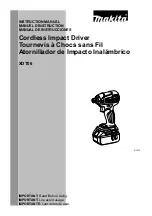
35
MAINTENANCE SECTION
Disassembly of the Reverse Valve Mechanism
The Reverse Valve Assembly cannot be removed
without first removing the Forward and
Reverse Buttons (4A) and (4B). Therefore, it is
important that the procedure below be followed
exactly.
1.
Notice the notches on either side of the partition.
These notches indicate the correct location for
insertion of a thin–bladed screwdriver used for
removing the Forward and Reverse Buttons. Insert the
screwdriver between the partition and the Button
which is fully extended. Gently pry against the
Button to disengage the detent so that the Button can
be removed. After the Button is removed, reach inside
the Housing and rotate the Reverse Valve to extend
the remaining Button. Repeat
the above procedure
for the remaining Button. Refer to Dwg. TPD1328.
(Dwg. TPD1328)
REMOVAL OF
FORWARD/
REVERSE
BUTTONS
2.
Insert thumb into the front of the Housing and push
down on the Reverse Valve so that it can be removed
through the bottom of the handle. Refer to Dwg.
TPD1329.
REVERSE
VALVE
(Dwg. TPD1329)
Do not try to remove the Reverse Valve by pushing
upward. It can only be removed by pushing it
downward and out of the bottom of the handle. If
the Reverse Valve does not come free, tap the
bottom of the handle lightly with a rubber hammer
until it drops out.
3.
Remove the Top Reverse Valve O–ring (3A) and the
Bottom Reverse Valve O–ring (3B) from the Reverse
Valve.
ASSEMBLY
General Instructions
1.
Whenever grasping a tool or part in a vise, always use
leather–covered vise jaws to protect the surface of the
part and help prevent distortion. This is particularly
true of threaded members and housings.
Always use leather–covered vise jaws when
clamping the handle in a vise. Leather will
conform to the shape of the handle and allow the
tool to be held securely. To prevent damage to the
exhaust diffuser, never clamp only the bottom of
the handle.
2.
Always clean every part and wipe every part with a
thin film of oil before installation.
Do not remove grease from the impact mechanism
or Hammer Case (15). If the impact mechanism
has not been disassembled, inject Ingersoll–Rand
No. 115–1LB Grease through the Hammer Case
Grease Fitting (17).
When disassembling and assembling the impact
mechanism, remove all grease from the impact
mechanism and Hammer Case and lubricate the
impact mechanism and Hammer Case Bushing (16)
with Ingersoll–Rand No. 105–1LB Grease or
Ingersoll–Rand No. 105–8LB Grease.
3.
Apply a film of o–ring lubricant to all O–rings before
final assembly.
Assembly of the Reverse Valve Mechanism
1.
Install the Bottom Reverse Valve O–ring (3B)
(color–coded blue) and the Top Reverse Valve bring
(3A) on the Reverse Valve (30).
2.
Insert the Reverse Valve in the bottom of the handle
making sure that two ears on the Reverse Valve are
facing downward. Refer to Dwg. TPD1330.
EARS
(Dwg. TPD1330)
Use a wooden dowel to push the Reverse Valve up
through the handle until the top of the Reverse
Valve is flush with or slightly above the bottom of
the motor bore in the Housing (19).
Refer to Dwg. TPD1331.
(Dwg. TPD1331)
DOWEL
If the Reverse Valve is pushed up too far and
becomes wedged, it will have to be pushed back
down through the the handle and re–inserted from
the bottom of the handle. The Reverse Valve
cannot be removed by pushing it up through the
handle and into the motor bore. If the Reverse
Valve must be removed and re–installed, make sure
that the Top and Bottom Reverse Valve O–rings
have not been rolled off and are in their proper
positions on the Reverse Valve.
















































